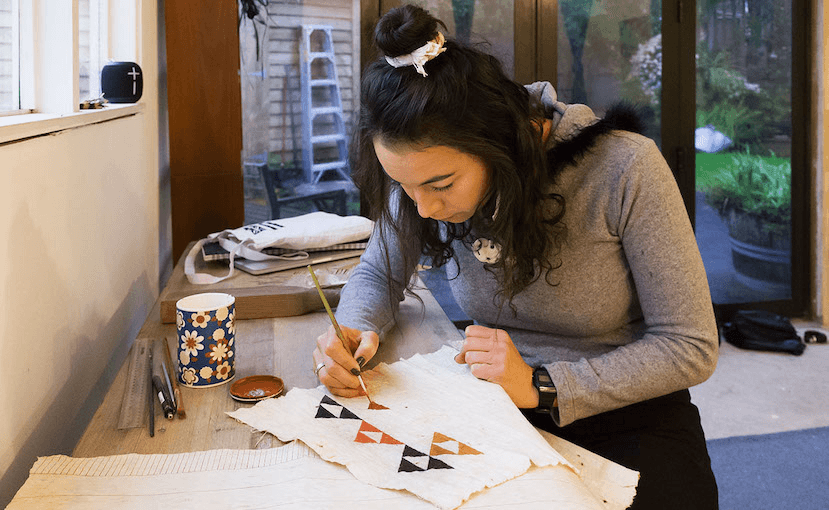Artist Nikau Hindin is reviving a contemporary form of Māori art that was largely lost after the extinction of the aute plant in Aotearoa.
Ngāpuhi and Te Rarawa artist Nikau Hindin has recently been taught by ancestors in Hawai’i the skills of beating tapa or barkcloth, reviving as contemporary form a Māori art largely lost after the extinction of the aute plant in Aotearoa. Aute was introduced to Aotearoa by Māori from the Pacific.
What do you like to have around you in the studio?
I am a cloth maker. I strip the bark from the aute, the paper mulberry tree, peel off the outer park, scrape and beat the inner sap. I paint star maps using kōkōwai, red earth. I don’t need much. Just an airtight bucket, my wooden tools, pigment and lots of dried aute. I hope to have piles of aute one day but that will take a long time and a lot of work. Plants need time to grow.
What are your tools and materials and where do you source them from?
Initially I made my tools, because you can’t exactly buy them in a shop. I looked at the old Māori tapa beaters at the Auckland Museum and sort of went from there. My first beater I made traditionally, with an adze, hoanga (a slab of sand stone), pipi shells and shark teeth to carve the grooves (my fingers were numb for a week). This is still my favourite beater today. It is made from pohutukawa. The hardest thing is acquiring hard woods. I’m lucky that my Kumu’s (teacher) brother in Hawai’i is probably one of the best wood craftsmen on the island (I’m biased), Sol Apio. He made this kua (anvil). It is made from milo and it is very hard. I brought it back from Hawai’i in my suitcase. It’s heavy too.
What’s the process of aute making, which we see here?
This piece I am scraping has already been harvested from the tree. This is the inner sap and it wraps around the inner stalk. It isn’t very wide now but once I beat it the fibres expand and it becomes much wider.
I then soak them to soften the fibres. Aute has very special qualities that make it self adhesive. I can layer a number of plants and beat them together to make bigger pieces and also to cover the natural pores (holes). Every island has different processes and even in Hawai’i individual makers have different methods. I’ve finally figured out what works for me but not without help. Verna Takashima, Kaliko Spencer and Uncle Wes Sen they have all been crucial in my learning and understanding of the fibre. The biggest teacher is the plant and I’m still learning.
And what do the patterns signify?
The lineage of my patterns come from tukutuku and tāniko. I do a lot of research and calculations for every star map I create. I did a series that documented what time the stars rise and set during Rākau Nui (full moon), over six moon cycles. This helped me to understand the seasonal changes of the stars and visually see it with pattern.
I like the idea that the composition is pre-determined by the times stars rise and set. This is knowledge our ancestors used to navigate to Aotearoa. Our modern navigators on board the waka Hokule’a, Haunui and many others need to have a clear picture of where all the stars are, above and below the horizon, to find direction.
If we wanted to realign ourselves with the timing of the environment, and the natural timing of our own internal environment we would have to be in synch with the Maramataka and then the next step is knowing the different stars which signify each moon cycle. I’m on a journey to understand how it all works. No doubt it will take me a life time. I use my paintings to help me memorise this knowledge. It takes such a long time to make the cloth. I think it should take equal time and care to make the marks on it.
We met you demonstrating aute making at the Auckland Art Fair – how important is passing the knowledge forward?
People are usually as surprised as I was to find out Māori also made tapa cloth. I started learning about aute in 2013 and it has taken till now to become comfortable with the process, gather the resources required to make it and also build relationships with knowledge holders. It is not just about making nice art objects, it is actually about understanding the right protocols and pathways to go about making.
I want to show people the incredible resources available in our environment, if only we knew how to unlock them. Eventually we are going to have to know how to use all the plants the way climate change is going. Passing this kind of knowledge forward is equally as important to me as passing forward the process of making aute.
Nikau Hindin (Te Rarawa, Ngāpuhi) completed her BA/BFA (Hons) at The University of Auckland. She started her Masters at the University of Hawai’i and is currently finishing it at Toihoukura in Turanga Nui a Kiwa, Gisborne. Nikau uses her Instagram to transmit knowledge and information about aute and her star maps. She is part of the collective Kauwaka, an online space which centres wāhine Māori perspectives. She has a show coming up in Wellington August 29 at Millers O’Brien and is part of Tākiri at the Maritime Museum in Auckland in October.
Names Held in Our Mouths runs until 18 August at Te Uru Waitakere Contemporary Gallery.
Sait Akkirman provides a fascinating account of the Auckland gallery scene documenting exhibition openings and providing exhibition listings at artdiary.co.nz.
In the Studio is inspired in part by Jim and Mary Barr’s Over the Net Studio visit series with New Zealand artists.
